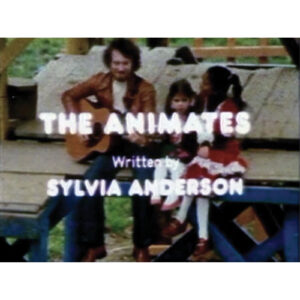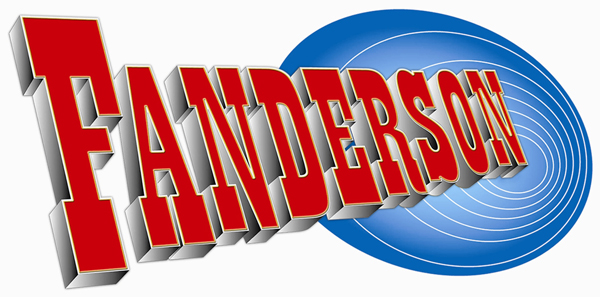
Sam Denham reviews Ian Fryer’s new book on the story behind the Andersons’ extraordinary creative partnership.
It was good timing when I recently received a copy of Ian Fryer’s ‘The Worlds of Gerry and Sylvia Anderson’, the latest non-fiction book inspired by the couple’s innovative and enduring productions, as I’d just been re-reading the first, Tim Heald’s ‘The Making of Space:1999’. Since Heald’s eyewitness report was written – exactly forty years ago – an increasing number of books have been produced about the Andersons and their pioneering films and television programmes, from the ‘primer’ Boxtree publications of the early 90s, to detailed episode guides, biographies and behind the scenes accounts. I think I’ve read all of them, and even had the chance to write one myself – 1993’s 21st Century Visions – for special effects supremo Derek Meddings. But as some have asked, is there really any need for another? I’d say undoubtedly ‘Yes’, Ian’s book shows that there are still novel ways to explore the Andersons’ creatively rich partnership.
Taking an overview of the productions the couple were involved with together from ‘The Adventures of Twizzle’ to ‘Space:1999’, Ian places them in the context of the world in which they were produced, and unlike other books which have largely focused on the technical aspects of how they were made or the recollections of those who made them, he gives an insight into the creative development of the production team’s work, focusing on elements such as story conception, music, and production design. In the section covering Stingray he highlights the increasingly sophisticated approach to scripting, which results in a series that achieves an entertaining balance between adventure, romance and humour, while in the section on UFO he discusses the eye-catchingly memorable – if impractical – aspects of the costume designs and Barry Gray’s equally memorable – and possibly more future-proof – score. Such observations help shed light on the continuing appeal of the Andersons’ shows to viewers, many decades after they were originally produced, and in this respect the book is unquestionably successful.

The book isn’t without certain flaws though, both in accuracy and presentation. Having carried out my own research into the history of AP Films and Century 21, an early interview with Arthur Provis revealed that John Read and Reg Hill were never directors of Pentagon Films, that AP Films only became established as an active production company after the commission to produce ‘The Adventures of Twizzle’ had been received, and that stories of Les Bowie having been based at Ipswich Road prior to AP Films’s arrival have somehow confused the order of events. This information is also corroborated in other publications and documentaries not referenced in Ian’s bibliography.
A number of other errors have crept in that possibly should have been picked up at an early stage. Such slips include Alan Fennell being described as the script editor of Thunderbirds instead of Alan Pattillo, and Gerry’s return to Pinewood, after originally working there as a dubbing editor, being said to be in 1973 with the production of ‘Space:1999’, when he’d clearly already returned some years earlier to make ‘Doppelganger’ and the last nine episodes of ‘UFO’ (these are also later referred to as having been filmed at Elstree Studios).
It’s also stated twice that ‘Space:1999’ was the only occupier of Pinewood’s stages during the course of its production, although I can readily think of two others – ‘The New Avengers’ in 1976, and ‘The Man With the Golden Gun’ in 1974 – that were both shot during the same period. Christopher Lee would have filmed his guest role in ‘Earthbound’ just prior to the Bond film’s main foreign location shoot and its subsequent return to Pinewood in the summer for the filming of its studio interiors.
The oddest claim made in the book is in the section covering the conception of the ‘Thunderbirds’ craft, where it’s stated that Derek Meddings based his designs of the vehicles on the shapes of the numbers assigned to them. Having interviewed Derek extensively about his work on ‘Thunderbirds’, he never mentioned that this affected his creative thinking, and during a recent conversation with Mike Trim, Mike supported the opinion that the craft were designed purely with a ‘form follows function’ philosophy – the only exception being Thunderbird 5, which was solely inspired by the shape of the Tracy Island roundhouse.
In terms of presentation the book takes a slightly idiosyncratic approach, being divided into sections, most of which are devoted to one particular production. In the case of each TV show, Ian has also chosen an episode to examine in more detail, and this helps to give a flavour of the particular series without giving away too many spoilers to readers who may not have seen them. In addition he provides potted biographies of cast and crew along the way, although these do tend to break up the flow of the text and might have been more effectively included in a separate section at the end of the book, as would the extensive opening list of acronyms.
Probably the weakest aspect of the book’s presentation though is the visual content. Given that it includes a beautifully glossy section full of colour images, it’s a shame that most of these are either book covers or lobby stills (including one from ‘The Man From Uncle’!), indicating that official picture rights may have been difficult to obtain. Even given this limitation, the selection of images strikes me as not having made the best use of the opportunity – perhaps greater use of studio or location images, or photographs of cast, crew and props from events and conventions might have added more variety.
Such criticisms aside, I enjoyed reading ‘The Worlds of Gerry and Sylvia Anderson’. Apart from the occasional factual inaccuracy, the book appears to be generally well-researched, and offers an objective and very readable account of the Andersons’ almost 20-year partnership. Ian clearly has a genuine love and enthusiasm for the subject and has provided a thoughtful and thought-provoking addition to the Anderson literary canon. Although perhaps ideally suited to those who are relatively new to the Andersons’ worlds, and at £25 in hardback not such good value as the recent ‘Thunderbirds Vault’ book, it still deserves a place on the bookshelves of anyone who loves the Andersons’ productions, or wants to learn about their creation. Forty years on, the snowball that Tim Heald started rolling with ‘The Making of Space:1999’ is still growing.
The Worlds of Gerry and Sylvia Anderson: The Story Behind International Rescue is available in hard back and Kindle editions from Amazon.

















 Issue 17 of the popular Gerry Anderson fanzine Andersonic is now available to buy online!
Issue 17 of the popular Gerry Anderson fanzine Andersonic is now available to buy online!